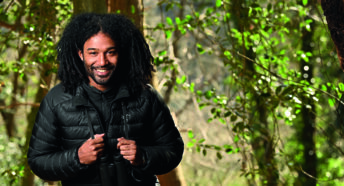Hayden Bridgeman: custodian of the countryside
National Park rangers are a familiar sight in the countryside – the interface between visitors, land managers and local people – but young women are increasingly changing perceptions about the role, reports Andrew McCloy
‘I never thought a young woman like me could become a full-time professional ranger,’ says 27-year-old Hayden Bridgeman from the New Forest National Park. ‘But I love the job, and the fact that I’m both protecting this fragile landscape and also helping people to enjoy and support it.’
Hayden’s first step on her own journey to becoming a National Park ranger was convincing herself that she could get the job. ‘There aren’t many openings, it’s super competitive, and you have to be well qualified,’ she explains. So, after volunteering overseas on conservation projects, she successfully applied for one of the New Forest National Park’s two apprentice ranger positions, involving a 13-month course with work placements that led to a diploma in environmental conservation.

Hayden says it helped widen her knowledge and expertise, as well as build her confidence as a woman seeking professional work in the countryside. While countryside ranger roles have perhaps traditionally been seen as male, Hayden is happy to report that this has changed.
‘About half the students on my course were female, which probably reflects the deep interest and passion we have for environmental issues,’ she says. ‘That said, I was the only girl on the chainsaw course, so perhaps we’re not quite there yet with equality! But the fact that we have an all-female ranger team at the New Forest is probably a reflection that an essential part of the job today is engagement and simply talking and listening to people.’
And there are certainly a lot of people for her to engage. The New Forest might be one of England’s youngest National Parks, created in 2005, but this popular and easily accessible part of Hampshire receives more visitors per square kilometre than any other National Park in the UK, with over 15 million day visits a year; and the pandemic has boosted that figure still further. But, amid the heightened awareness of our special landscapes and the desire to get outdoors, some of the behaviour of the newer visitors has proved challenging – and rangers are on the front line.

For Hayden, it’s about helping people to understand and enjoy the countryside responsibly; for instance, explaining why barbecues in the forest are not allowed, or why dogs must be kept under control. ‘I’m also very clear that this is a working forest,’ she says, ‘and so, for me, an important relationship that I have as a ranger is with the people who live here, such as the commoners and agisters.’
Hayden admits that managing these different interests can be challenging at times but ultimately rewarding, and it gives her a tremendous sense of purpose. ‘A day doesn’t go by without me thinking how lucky I am to be working in this special landscape. I feel proud that I’m helping to present a picture of real change, and making the countryside more accessible and inclusive.’
A version of this article was originally published in CPRE’s award-winning magazine, Countryside Voices. You’ll have Countryside Voices sent to your door three times a year, as well as access to other benefits including discounts on attraction visits and countryside kit from major high street stores when you join as a CPRE member. Join us now.









